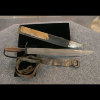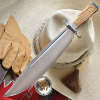Panzerschwein
member
Okay, guys. After reading all of your helpful comments, I do want the knife to be good for brush clearing and cutting sticks for firewood, maybe even batoning. I'd also want it to be good for fighting. So, do you think this would be a better blade for said tasks:

Also more like this:

I'm sure Mr. Brock hasn't forged my knife yet. Any and all input is appreciated so much everyone. I've never owned a Bowie knife, much less had one custom made for me!!

Also more like this:

I'm sure Mr. Brock hasn't forged my knife yet. Any and all input is appreciated so much everyone. I've never owned a Bowie knife, much less had one custom made for me!!



